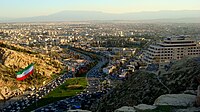
Photo from wikipedia
[A tectonic model for the evolution of the Zagros Orogenic Belt based on the different types of melanges in the Neyriz region. , Abstract Melanges are formed by sedimentary, tectonic… Click to show full abstract
[A tectonic model for the evolution of the Zagros Orogenic Belt based on the different types of melanges in the Neyriz region. , Abstract Melanges are formed by sedimentary, tectonic and diapiric processes and are generally found in collisional belts. The Zagros Orogeny provides an intriguing geological laboratory for the study of melange‐forming processes during the progressive tectonic evolution of the Neotethys Ocean. Different types of tectonic and sedimentary melanges occur in specific structural positions within the Zagros orogenic belt in the Neyriz Region (Iran). Based on their block‐in‐matrix fabrics, and tectonostratigraphic positions, we differentiated 14 different melange types, which mark different episodes of the tectonic evolution of the Neyriz Region from the Cretaceous subduction to the Miocene collision. The Cretaceous subduction stage is recorded by volcanic‐sedimentary melanges (Mv). Sedimentary melanges characterized by megabreccia from the Cretaceous limestone (Ms1) and Eocene polymictic megabreccia (Ms2) represent epi‐nappe melanges formed during the Palaeocene–Eocene in wedge‐top basins. The ophiolite emplacement in the Oligocene resulted in local extensional tectonics in the upper part of the ophiolitic nappe, and deposition of a polymictic megabreccia (Ms3, Ms4). As the final production of the Neotethys Ocean closure and the Eurasian‐Arabian collision, the sedimentary melanges characterized by different types of chaotic rock units (Ms5, Ms6, Ms7 and Ms8 facies) were developed in front of the Cretaceous–Eocene nappes due to growth of the orogenic wedge in the Miocene. Our findings indicate that the recognition and distinction of different types of melange may provide additional constraints for a better understanding of the tectono‐sedimentary evolution of the Neotethyan region.]
Journal Title: Basin Research
Year Published: 2020
Link to full text (if available)
Share on Social Media: Sign Up to like & get
recommendations!